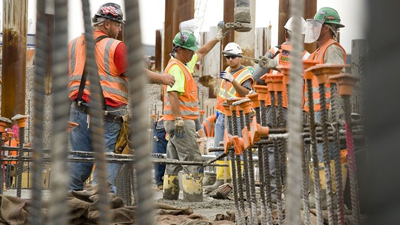PPIs in February, prospective prices are mixed; industry execs expect increased activity
 Editor’s note: Construction Citizen is proud to partner with AGC America to bring you AGC Chief Economist Ken Simonson's Data DIGest. Check back each week to get Ken's expert analysis of what's happening in our industry.
Editor’s note: Construction Citizen is proud to partner with AGC America to bring you AGC Chief Economist Ken Simonson's Data DIGest. Check back each week to get Ken's expert analysis of what's happening in our industry.
The producer price index (PPI) for final demand decreased 0.3%, not seasonally adjusted (-0.5%, seasonally adjusted), in February and 0.6% over 12 months, the Bureau of Labor Statistics (BLS) reported Friday. AGC posted an explanation and tables focusing on construction prices and costs. Final demand includes goods, services and five types of nonresidential buildings that BLS says make up 34% of total construction. The PPI for final demand construction, not seasonally adjusted, rose 0.2% in February and 2.0% over 12 months. The overall PPI for new nonresidential building construction—a measure of the price that contractors say they would charge to build a fixed set of five categories of buildings—climbed 2.0% since February 2014. The 12-month increases ranged from 1.0% for healthcare construction to 1.7% for schools, 2.1% for industrial buildings, 2.2% for warehouses, and 2.5% for offices. PPIs for new, repair and maintenance work on nonresidential buildings by electrical contractors increased 0.9% over 12 months; plumbing contractors, 1.3%; concrete contractors, 2.4%; and roofers, 3.8%. A new set of PPIs for inputs to construction, excluding capital investment, labor and imports, adds services to the previous PPI for inputs to construction industries, now renamed inputs to construction industries, goods. Goods now constitute 60% of the index (including 7% for energy); services, 40% (trade services, 25%; transportation and warehousing services, 4%; other services, 10%). The overall PPI for inputs to construction rose 0.4% from January to February, as there were increases in the indexes for energy (3.8%) and services (0.7%), while the index for goods less food and energy was flat for the month. The PPI for all goods used in construction declined 3.9% over 12 months. Materials with notable one- or 12-month price changes include diesel, up 3.3% for the month but down 41% over 12 months; copper and brass mill shapes, -2.6% and -11%, respectively; aluminum mill products, -0.9% and 4.4%; concrete products, 0.2% and 4.4%; and cement, 0 and 9.4%. Prices for gypsum products increased 3.9% in February, following a 4.3% rise in January, but the 12-month change was only 1.6%. On March 19, BLS will conduct a webinar on the latest PPI changes, hosted by the National Association for Business Economics.
Investment research firm Thompson Research Group issued a summary of its monthly survey of building products firms on Monday. "It appears that into early March, key roofing manufacturers are holding firm on pricing, reporting stable sequential pricing....With raw steel costs falling, so too did steel stud pricing in the market. Wallboard [pricing was flat month-to-month and up year-over-year] but gains remain uneven by geography. Insulation – 60% report sequential increases in pricing. Flooring...pricing flattish; little chance of spring price increase. Ceiling...67% 'undecided' on the success of the 5% Feb ceiling price increase – still too early to tell."
"Construction industry executives representing large and small contractors as well as equipment distributorships and rental companies are showing continued optimism that local nonresidential activity will increase in the year ahead compared to 2014," Wells Fargo Equipment Finance reported on February 26 in releasing its annual forecast survey. The survey was conducted January 8-30 and drew 413 responses from 48 states. "In contrast to previous Forecasts, we're seeing more consistency between residential and nonresidential construction; optimism about improvement in both sectors is equally positive....More contractors than a year ago say they will be renting. Distributors and equipment rental companies say they are already renting out more equipment to contractors than a year ago. They also say they will likely grow their rental fleets. Equipment acquisition is also likely to rise. More contractors than a year ago say they will increase new and used equipment acquisitions. Distributors are more optimistic about sales increases in new and used categories than in either of the previous two years."
Seasonally adjusted results from Manpower Group's latest survey of 18,000 U.S. employers, released on Tuesday, "suggest that employers expect hiring intentions to remain relatively stable during Quarter 2 2015 compared to Quarter 1 2015 and to increase compared to one year ago at this time....employers have a positive outlook in all 13 industry sectors included in the survey...When the industry sector data is compared quarter-over-quarter,...staff levels are expected to remain relatively stable in [construction and five other sectors]. Hiring plans contracted slightly in the construction [sector in the Midwest]. Employers in the construction [sector in the West] expect hiring to increase slightly." Construction employers in the South and Northeast "expect hiring to remain relatively stable." Combining responses from all sectors, "all 100 of the largest Metropolitan Statistical Areas (MSA) in the United States report positive Net Employment Outlooks," led by Boise, Idaho; Jacksonville, Fla.; Grand Rapids, Mich.; Milwaukee; and Seattle.
"Anybody who thought the strength that fundamental apartment market metrics demonstrated in 2014 would suddenly change with the new year thought wrong," real-estate data provider Axiometrics Inc. reported Friday. "Annual effective rent growth, for one, has reached heights not seen in 44 months....February's occupancy rate of 94.7% was the highest of any February since the end of the recession. This marks the 61st straight month in which the occupancy rate has been higher than the same month of any preceding year since 2009."
The Data DIGest is a weekly summary of economic news; items most relevant to construction are in italics. All rights reserved. Sign up at www.agc.org/datadigest.


